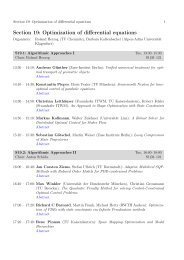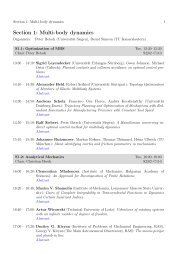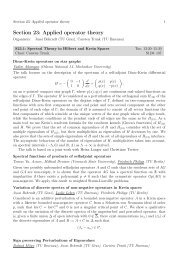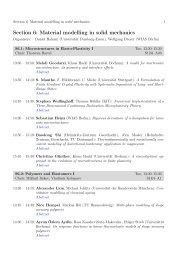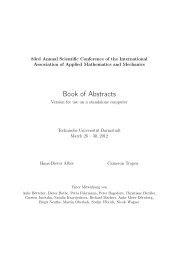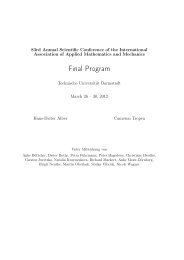Section 6: Material modelling in solid mechanics - GAMM 2012
Section 6: Material modelling in solid mechanics - GAMM 2012
Section 6: Material modelling in solid mechanics - GAMM 2012
Create successful ePaper yourself
Turn your PDF publications into a flip-book with our unique Google optimized e-Paper software.
4 <strong>Section</strong> 6: <strong>Material</strong> <strong>modell<strong>in</strong>g</strong> <strong>in</strong> <strong>solid</strong> <strong>mechanics</strong><br />
when the deformation is constant <strong>in</strong> time. The constitutive relations for the stress tensor and the<br />
<strong>in</strong>ternal variables are deduced us<strong>in</strong>g the Clausius-Duhem <strong>in</strong>equality. In order to sketch the ma<strong>in</strong><br />
properties of the model, expressions <strong>in</strong> closed form are derived with respect to cont<strong>in</strong>uous and<br />
<strong>in</strong>termittent relaxation tests as well as for the compression set test. Under the assumption of near<br />
<strong>in</strong>compressible material behaviour, the theory can also represent age<strong>in</strong>g-<strong>in</strong>duced changes <strong>in</strong> volume<br />
and their effect on the stress relaxation. The simulations are <strong>in</strong> accordance with experimental<br />
data from literature.<br />
[1] A. Lion, M. Johlitz, On the representation of chemical age<strong>in</strong>g of rubber <strong>in</strong> cont<strong>in</strong>uum <strong>mechanics</strong>,<br />
International Journal of Solids and Structures, under review.<br />
Multi-phase model<strong>in</strong>g of shape memory polymers<br />
Nico Hempel, Markus Böl (TU Braunschweig)<br />
Shape memory polymers are a highly versatile class of so-called smart materials. They are able to<br />
store a certa<strong>in</strong> state of deformation and remember another one by means of an external stimulus<br />
such as light or temperature. Usually, the physical mechanism responsible for this behavior is a<br />
temperature-dependent phase transition between an “active”, entropy-elastic phase and a “frozen”,<br />
energy-elastic phase. As polymers are usually capable of experienc<strong>in</strong>g large deformations, models<br />
are required which are able to represent both the phase transitions and states of large deformation.<br />
In the present work, we propose a model based on the idea of the multiplicative decomposition<br />
of the deformation gradient. Evolution equations for the several deformation components are<br />
presented that provide for the storage of the entropy-elastic stra<strong>in</strong> and its recovery dur<strong>in</strong>g the<br />
transition between the frozen phase and the active phase. First characteristic shape memory cycles<br />
will be presented as a last po<strong>in</strong>t.<br />
On response functions <strong>in</strong> l<strong>in</strong>ear thermoelastic models of shape memory polymers<br />
Aycan Özlem Ayd<strong>in</strong>, Rasa Kazakevičiute-Makovska , Holger Steeb (Universität Bochum)<br />
There are two basic classes of constitutive models for thermoresponsive Shape Memory Polymers<br />
(SMPs), rheological and thermoelastic models. In this work, we present a detailed analysis of<br />
l<strong>in</strong>ear thermoelastic models. The first model with<strong>in</strong> this class has been proposed by Liu et al. [1]<br />
and <strong>in</strong> the follow<strong>in</strong>g years numerous modifications of that model have been presented (cf. e.g. [2]).<br />
All these models have a common mathematical structure with three basic response functions.<br />
Different models developed with<strong>in</strong> this concept follow from the general theory by specifications<br />
of the relevant response functions. The general mathematical form of the response functions<br />
is discussed and an experimental methodology determ<strong>in</strong><strong>in</strong>g of response functions directly from<br />
experimental data is presented. Representative examples illustrate the quality and the efficiency<br />
of the proposed methodology. It is shown that a reliable evaluation of thermoelastic models for<br />
SMPs requires a comparison with data for all four steps of the termomechanical cycle, both under<br />
stra<strong>in</strong>- and stress controlled conditions.<br />
[1] Y. Liu, K. Gall, M. L. Dunn, A. R. Greenberg, J. Diani, Thermo<strong>mechanics</strong> of shape memory<br />
polymers: Uniaxial experiments and constitutive model<strong>in</strong>g, Int. J. Plasticity, vol. 22, pp.<br />
279-313, 2006.<br />
[2] R. Kazakevičiute-Makovska, H. Steeb, A. Özlem Aydın, On the evolution law for the frozen<br />
fraction <strong>in</strong> the l<strong>in</strong>ear theories of shape memory polymers, Arch. App. Mech., <strong>in</strong> press, 2011.



